Application of Innovative SMA-MA Mixtures on Bridges
Abstract
:1. Conventional Asphalt Pavements Used on Bridges
- Spread the loads over the bridge deck;
- Dampen the dynamic effects caused by traffic loading;
- Accommodate strains of the bridge deck caused by temperature variation in the range −30 °C to +70 °C;
- Ensure the required interlayer bond, including bond between the waterproofing layers and the deck;
- Ensure the required evenness, tightness, surface roughness and resistance to abrasion, rheological effects and rutting;
- Reduce sensitivity of the asphalt mixtures to both low and high temperatures.
- Be impervious to water, water vapor and gases;
- Be resistant to the action of chemicals related to operation and maintenance of roads;
- Have smooth surface to facilitate drainage of water from the surface and reinforcing fleece embedded in the binder (if designed);
- Be made of materials whose coefficient of thermal expansion is similar to that of the bridge deck,
- Be elastic over a wide temperature range (–30 °C to +70 °C);
- Adhere well to base and ensure good bond with the protective or wearing courses (in the case of one-layer surfacing systems);
- Be resistant to mechanical damage and the working temperatures of asphalt mixture used for the protective layer (at least 160–240 °C).
- Burning through the membrane during application (the temperature of burned gasses during heating up the underside of the membrane with a gas torch can reach from about 700 °C to as much as 1400 °C) (Figure 2).
- Forming of bulges during placement of the protective layer due to local lack of adhesion between the membrane and substrate and the increase in partial pressure of air in the voids.
- Destruction of membrane (structural degradation).
- Special pavers and vehicles are needed, which due to a relatively low availability and low throughput of this kind of plant considerably extends the process of construction, in relation to the projects where conventional asphalt mixtures are used;
- High temperatures during production of mastic asphalt have a negative impact on the natural environment and increase the risk of overheating the bitumen;
- Use of a layer of mastic asphalt may lead to cracking (longitudinal and transverse) and de-bonding of layers as a result of shrinkage, especially when there are considerable temperature differences of ambient air and longitudinal joint construction is applied because full-width working is not possible (Figure 3 and Figure 4);
- It is not possible to check the composition of MA mixtures immediately after production due to, inter alia, a lack of filler heating systems in asphalt mixing plants.
2. Innovative SMA-MA Mixtures—Brief History, General Information
- Placement by conventional asphalt pavers;
- The range of working temperatures does not depart much from the temperatures typically used in the case of asphalt concrete or SMA mixtures (lower by 40–60 °C than the temperatures used for mastic asphalts);
- Lower risk of overheating the binder during lay-down;
- High tightness of the layer;
- Fatigue resistance owing to an increased content of medium penetration bitumen (mainly modified).
3. Use of SMA-MA Mixture—Case Study
3.1. Bridge Description
3.2. SMA-MA Protective Layer
- Critical temperature (T(S)60) at 300 MPa creep stiffness;
- Critical temperature at the value of m (T(m)60) equal to 0.3;
- Stiffness of bitumen at the temperature of −16 °C (S(T)-16).
3.3. Pavement Lay-Down Process
4. Conclusions
- After over 20 years from the first implementations we can state that SMA-MA mixtures feature the required durability and load capacity;
- The construction joints (hot-to-cold) after placement of SMA-MA mixture ensure tightness and uniformity of the surface (without the need of additional sealing), thus enabling staged, lane-by-lane construction;
- SMA-MA mixtures are produced in standard batching plants at much lower (i.e., by 40–60 °C) temperatures as compared to MA mixtures, thus reducing the carbon footprint and increasing the throughput;
- SMA-MA can be laid down by typical hot mix asphalt pavers, which considerably reduces the construction time (as compared to MA mixtures);
- The SMA-MA protective course in combination with spray applied liquid resin waterproofing systems, such as methyl methacrylate products, enables reducing the negative effect of the increase in pressure in the air voids under the torch-on membrane layer;
- Polymer-modified bitumen gives the mixture high fatigue resistance and good low-temperature performance, which is of particular importance on steel bridges.
Author Contributions
Funding
Conflicts of Interest
References
- Judycki, J.; Jaskuła, P.; Pszczoła, M.; Ryś, D.; Jaczewski, M.; Alenowicz, J.; Dołżycki, B.; Stiness, M. Analizy i Projektowanie Konstrukcji Nawierzchni Podatnych i Półsztywnych; WKŁ: Warszawa, Poland, 2014; ISBN 978-83-206-1928-7. [Google Scholar]
- Ara, Inc. Guide for Mechanistic-Empirical Design of New and Rehabilitated Pavement Structures, Final Report, Part 3–Design and Analysis; NCHRP, TRB, NRC: Champaign, Illinois, 2004. [Google Scholar]
- Ministere de l’Equipement, des Transports et du Tourism. French Design Manual for Pavement Structures, Guide Technique; LCPC, SETRA: Paris, France, 1997. [Google Scholar]
- Radziszewski, P.; Piłat, J.; Sarnowski, M.; Kowalski, K.; Pokorski, P.; Liphardt, A. Rozwiązania Materiałowo-Technologiczne Izolacji i Nawierzchni Obiektów Mostowych; Raport Końcowy; GDDKiA: Warsaw, Poland, 2013. [Google Scholar]
- Caliendo, C. Simplified models for estimating stresses and strains in pavements on concrete and steel bridges. IJCIET 2017, 8, 1273–1282. [Google Scholar]
- Castro, M. Structural design of asphalt pavement on concrete bridges. Can. J. Civ. Eng. 2004, 31, 695–702. [Google Scholar] [CrossRef]
- Piłat, J.; Radziszewski, P.; Kowalski, K. Jaka nawierzchnia, taki most. Nowocz. Bud. Inżynieryjne 2007, 3, 4. [Google Scholar]
- Madaj, A.; Wołowicki, W. Budowa i Utrzymanie Mostów; WKŁ: Warszawa, Poland, 2009; ISBN 978-83-206-1848-8. [Google Scholar]
- Sybilski, D. Bitumiczne nawierzchnie mostowe. Drogownictwo 1994, 7, 232–238. [Google Scholar]
- Rozporządzenie ministra Transportu i Gospodarki Morskiej w sprawie warunków technicznych, jakim powinny odpowiadać drogowe obiekty inżynierskie i ich usytuowanie. Dz.U. 2000, 63, 735.
- Wegan, V. Surfacing of Concrete Bridges; Report No. 106; Danish Road Institute: Roskilde, Denmark, 2000; ISBN 87-90145-71-2. [Google Scholar]
- Głomb, J. Tendencje rozwojowe w projektowaniu nawierzchni mostów drogowych. Drogownictwo 1972, 86–92. [Google Scholar]
- Śliwiński, J.; Furtak, K. Materiały Budowlane w Mostownictwie; WKŁ: Warszawa, Poland, 2004; ISBN 978-83-206-1531-9. [Google Scholar]
- Piłat, J.; Radziszewski, P. Nawierzchnie Asfaltowe; WKŁ: Warszawa, Poland, 2007; ISBN 978-83-206-1759-7. [Google Scholar]
- Kilarski, A. Analiza i Ocena Materiałów Hydroizolacyjnych na Pomosty Obiektów Mostowych; IBDiM: Warsaw, Poland, 1996. [Google Scholar]
- Piłat, J.; Radziszewski, P. Izolacje przeciwwodne obiektów mostowych. Materiały Budowlane 2003, 4, 72–73. [Google Scholar]
- Germaniuk, K.; Kilarski, R.; Łukowski, P.; Michalowska, M.; Pryga, A.; Wysokowski, A.; Żurawicka, A. Katalog Zabezpieczeń Powierzchniowych Drogowych Obiektów Inżynierskich; Instytut Badawczy Dróg i Mostów: Warsaw, Poland, 2002. [Google Scholar]
- Radziszewski, P.; Piłat, J.; Sarnowski, M.; Kowalski, K.; Król, K.J. Nawierzchnie Asfaltowe na Obiektach Mostowych; Oficyna Wydawnicza Politechniki Warszawskiej: Warszawa, Poland, 2016. [Google Scholar]
- Mieczkowski, P. Nowe papy termozgrzewalne - układy wentylowane. Izolacje 2010, 15, 36–42. [Google Scholar]
- Danowski, M. Doświadczenia z izolacjami i nawierzchniami na obiektach mostowych. Nowości Zagranicznej Techniki Drogowej 2000, 141, 85–104. [Google Scholar]
- Radziszewski, P.; Piłat, J.; Sarnowski, M. Influence of high temperature on properties of materials used in bridge asphalt pavement structures. Roads Bridges Drogi Mosty 2015, 175–191. [Google Scholar] [CrossRef]
- WT-2 2014—część I Mieszanki mineralno-asfaltowe. In Wymagania Techniczne; Generalna Dyrekcja Dróg Krajowych i Autostrad: Warsaw, Poland, 2014.
- Zou, G.; Xu, X.; Li, J.; Yu, H.; Wang, C.; Sun, J. The Effects of Bituminous Binder on the Performance of Gussasphalt Concrete for Bridge Deck Pavement. Materials 2020, 13, 364. [Google Scholar] [CrossRef] [PubMed] [Green Version]
- Luo, S.; Qian, Z.; Yang, X.; Wang, H. Design of gussasphalt mixtures based on performance of gussasphalt binders, mastics and mixtures. Constr. Build. Mater. 2017, 156, 131–141. [Google Scholar] [CrossRef]
- Nikolaidēs, A. Highway Engineering: Pavements, Materials and Control of Quality; CRC Press: Boca Raton, FL, USA, 2017; ISBN 978-1-138-89376-4. [Google Scholar]
- EN 13108-6:2016-07 Bituminous Mixtures—Material Specifications—Part 6, Mastic Asphalt; CEN: Brussels, Belgium, 2016.
- Mazumder, M.; Kim, H.; Lee, S.-J. Performance properties of polymer modified asphalt binders containing wax additives. Int. J. Pavement Res. Tech. 2016, 9, 128–139. [Google Scholar] [CrossRef] [Green Version]
- Budziński, B.; Mieczkowski, P.; Sarnowski, M. Doświadczenia w Zastosowaniu Technologii SMA-MA; Krakowskie Dni Nawierzchni: Kraków, Poland, 2016. [Google Scholar]
- Mieczkowski, P. Warstwy ochronne z mieszanek mineralno-asfaltowych na obiektach mostowych Izolacje. Izolacje 2012, 10, 54–61. [Google Scholar]
- Mieczkowski, P. Alternatywne systemy izolacji płyt obiektów mostowych. Mag. Autostrady 2014, 10, 30–34. [Google Scholar]
- Mieczkowski, P. Hydroizolacja płyt pomostów na obiektach mostowych. Bud. Most. Vadem. 2015, 11–17. [Google Scholar]
- Giu-Lian, Z.; Xiao-Ning, Z.; Chung, W. Evaluation of Steel Bridge Deck Ma Mixture Properties during Construction. J. Mar. Sci. Technol. 2015, 23, 293–301. [Google Scholar] [CrossRef]
- Bichajło, L.; Siwowski, T. Nawierzchnie na obiektach mostowych—doświadczenia z nadzoru nad realizacją. Sympozjum: Nawierzchnie i izolacje na obiektach inżynieryjnych betonowych i stalowych. Konsekwencje i możliwości działań. In Proceedings of the XVII Międzynarodowe Targi Budownictwa Drogowego AUTOSTRADA-POLSKA, Kielce, Poland, 11–12 May 2011. [Google Scholar]
- Hailesilassie, B.; Partl, M. Mechanisms of asphalt blistering on concrete bridges. J. ASTM Int. 2012, 9, 1–16. [Google Scholar] [CrossRef]
- Rosenberg, J. Thin Pavements with Synthetic Binder Used in Denmark, Report No. 105; Danish Road Institute: Roskilde, Denmark, 2001; ISBN 978-87-90145-73-6. [Google Scholar]
- Hailesilassie, B.W.; Partl, M.N. Adhesive blister propagation under an orthotropic bituminous waterproofing membrane. Constr. Build. Mater. 2013, 48, 1171–1178. [Google Scholar] [CrossRef]
- Mieczkowski, P. Mastyks grysowy (SMA) jako warstwa izolacyjna pod nawierzchnie bitumiczne na obiektach inżynierskich. In Splittmastix as an Insulation for Roads’ Pavements on an Engineering Objects; IBDiM: Kielce, Poland, 2000; pp. 155–161. [Google Scholar]
- Radziszewski, P.; Sarnowski, M.; Piłat, J.; Mieczkowski, P.; Król, K.J. Innovative SMA-MA Mixture for Bridge Asphalt Pavement. In Proceedings of the 6th Eurasphalt & Eurobitume Congress, Prague, Czech Republic, 1–3 June 2016. [Google Scholar]
- Stosh, H.J. Błędy Wykonawstwa Nawierzchni Bitumicznych; WKŁ: Warszawa, Poland, 1977. [Google Scholar]
- Sarnowski, M.; Radziszewski, P.; Piłat, J.; Kowalski, K.J.; Król, J.B. Ocena trwałości mieszanek mineralno-asfaltowych stosowanych do izolacji i nawierzchni obiektów mostowych. Bud. Archit. 2014, 13, 233–241. [Google Scholar] [CrossRef]
- Pokorski, P.; Radziszewski, P.; Sarnowski, M. Odporność na deformacje trwałe asfaltowych nawierzchni mostowych. ZNPRzBiS 2016, 63, 429–436. [Google Scholar] [CrossRef] [Green Version]
- Pokorski, P.; Radziszewski, P.; Sarnowski, M. Rheological Properties of Asphalt Mixtures for Bridge Pavements. Procedia Eng. 2015, 111, 637–644. [Google Scholar] [CrossRef]
- Gałecki, M.; Kasprzak, A.; Berger, A.; Nadolny, A. Aspekty wykonawcze przebudowy mostu gen. Grota-Roweckiego w Warszawie. Arch. Inst. Inżynierii Lądowej Politech. Poznańska 2015, 19, 57–73. [Google Scholar]
- Mieczkowski, P. Izolacje z pap asfaltowych na mostach. Izolacje 2010, 2, 16–18. [Google Scholar]
- Hołowaty, J. Multi-Span Bridge Crossing for Improved Road Access to Szczecin Sea Port; CRC Press: Porto, Portugal, 2015. [Google Scholar]
- PN-EN 1426:2015-08. Determination of needle penetration. In Bitumen and Bituminous Binders; PKN: Warsaw, Poland, 2015. [Google Scholar]
- EN 1427:2015-08. Determination of the softening point - Ring and Ball method. In Bitumen and Bituminous Binders; PKN: Warsaw, Poland, 2015. [Google Scholar]
- PN-EN 14771:2012. Determination of the flexural creep stiffness—Bending Beam Rheometer (BBR). In Bitumen and Bituminous Binders; PKN: Warsaw, Poland, 2012. [Google Scholar]
- PN-EN 13398:2017-12. Determination of the elastic recovery of modified bitumen. In Bitumen and Bituminous Binders; PKN: Warsaw, Poland, 2017. [Google Scholar]
- PN-EN 12591:2010. Specifications for paving grade bitumens. In Bitumen and Bituminous Binders; PKN: Warsaw, Poland, 2010. [Google Scholar]
- PN-EN 12697-46:2012. Bituminous Mixtures—Test Methods for Hot Mix Asphalt—Part 46: Low Temperature Cracking and Properties by Uniaxial Tension Tests; PKN: Warsaw, Poland, 2020. [Google Scholar]
- PN-EN 14023:2011. Specification framework for polymer modified bitumens. In Bitumen and Bituminous Binders; PKN: Warsaw, Poland, 2011. [Google Scholar]
- PN-EN 12697-30:2012. Bituminous Mixtures—Test Methods for Hot Mix Asphalt—Part 30: Specimen Preparation by Impact Compactor; PKN: Warsaw, Poland, 2012. [Google Scholar]
- PN-EN 12697-8:2005. Bituminous Mixtures—Test Methods for Hot Mix Asphalt—Part 8: Determination of Void Characteristics of Bituminous Specimens; PKN: Warsaw, Poland, 2005. [Google Scholar]
- PN-EN 12697-33:2008. Bituminous Mixtures—Test Methods for Hot Mix Asphalt—Part 33: Specimen Prepared by Roller Compactor; PKN: Warsaw, Poland, 2008. [Google Scholar]
- PN-EN 12697-22:2008. Bituminous Mixtures—Test Methods for Hot Mix Asphalt—Part 22: Wheel Tracking; PKN: Warsaw, Poland, 2008. [Google Scholar]
- PN-EN 13108-20:2016-07. Bituminous Mixtures—Material Specifications—Part 20: Type Testing; PKN: Warsaw, Poland, 2016. [Google Scholar]
- PN-EN 12697-12:2008. Bituminous Mixtures—Test Methods—Part 12: Determination of the Water Sensitivity of Bituminous Specimens; PKN: Warsaw, Poland, 2008. [Google Scholar]
- PN-EN 12697-18:2017-07. Bituminous Mixtures—Test Methods—Part 18: Binder Drainage; PKN: Warsaw, Poland, 2017. [Google Scholar]
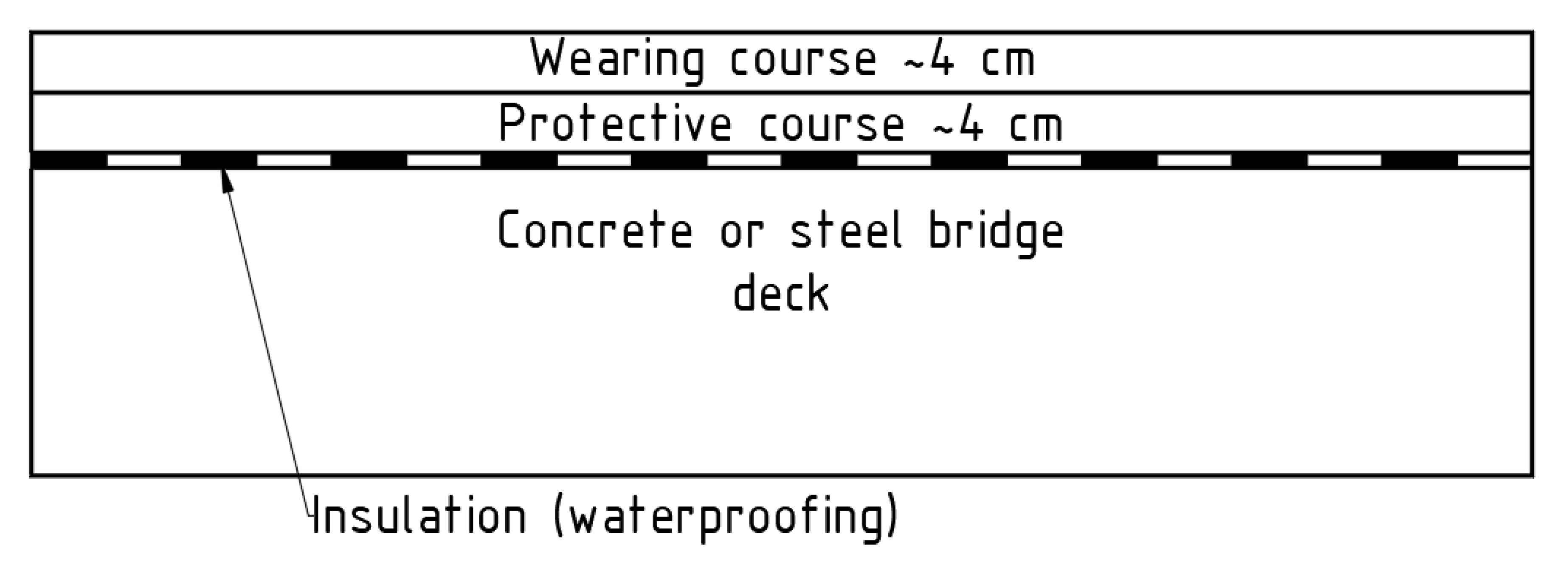

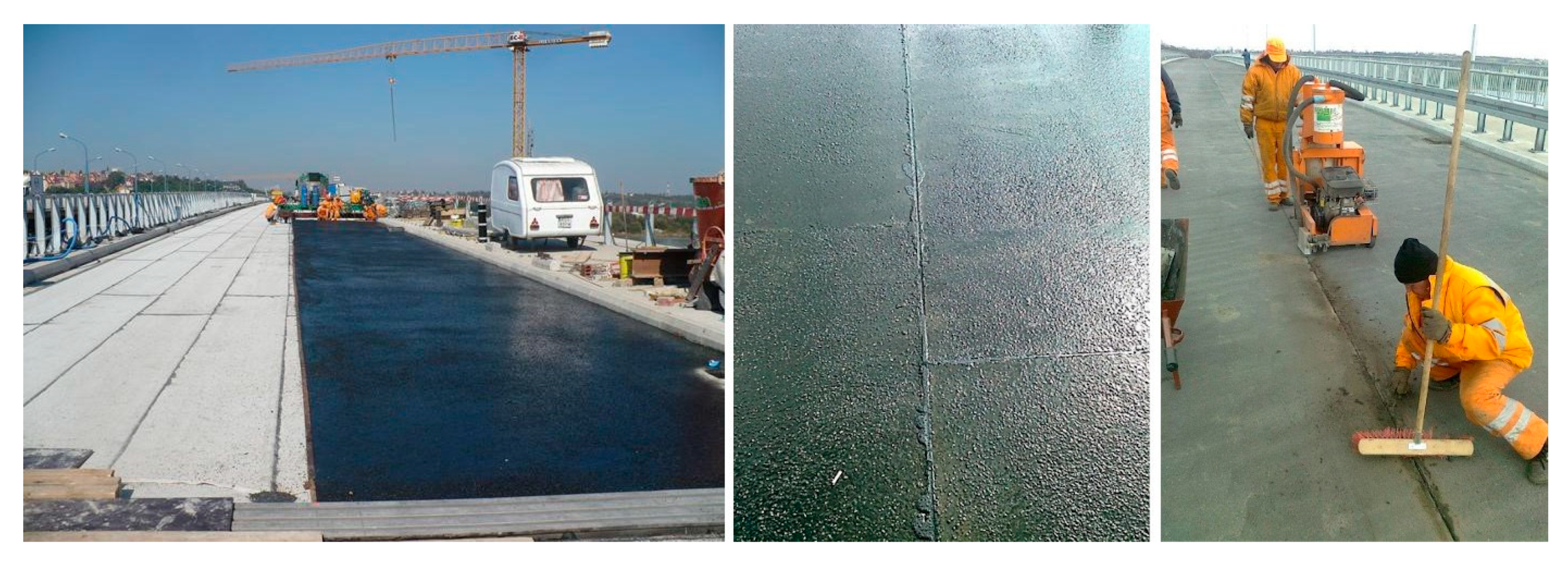
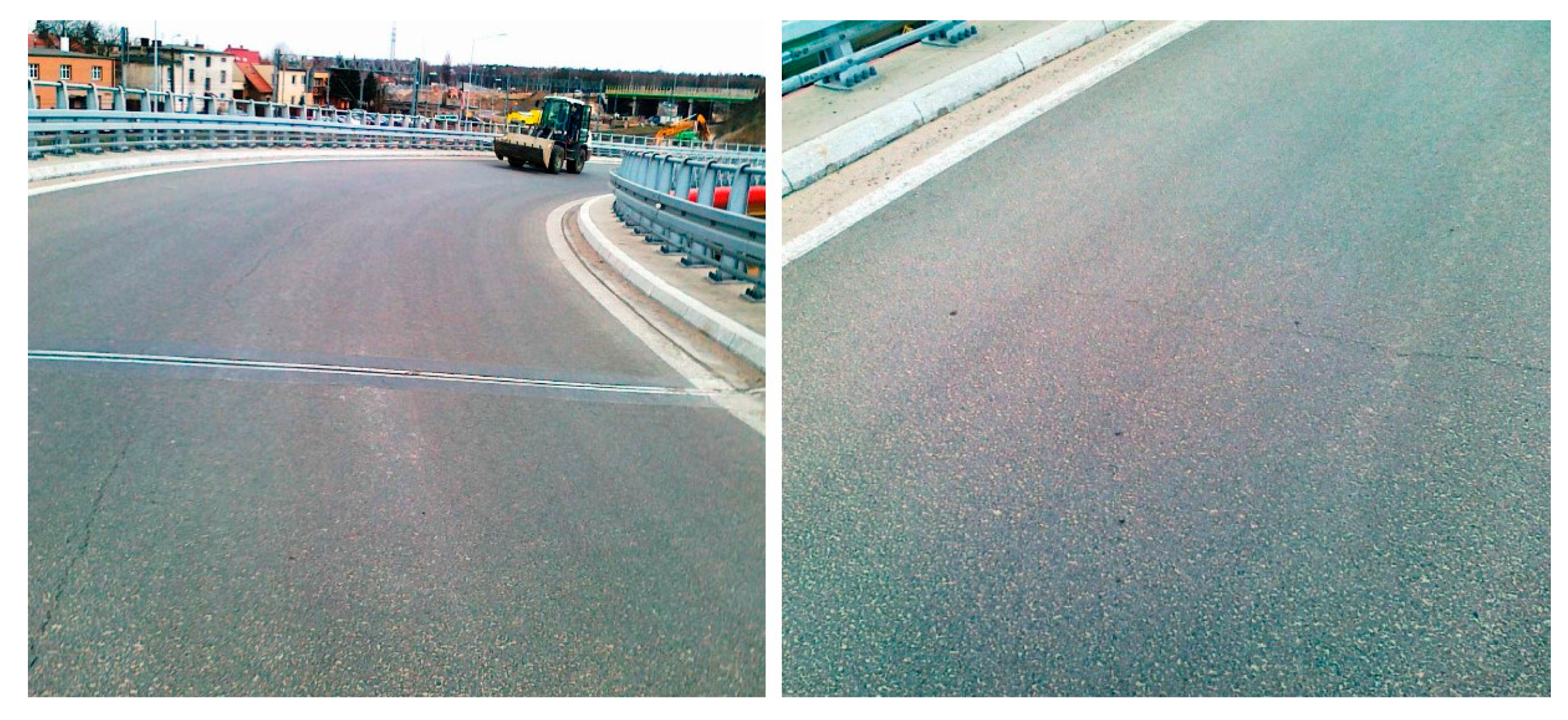


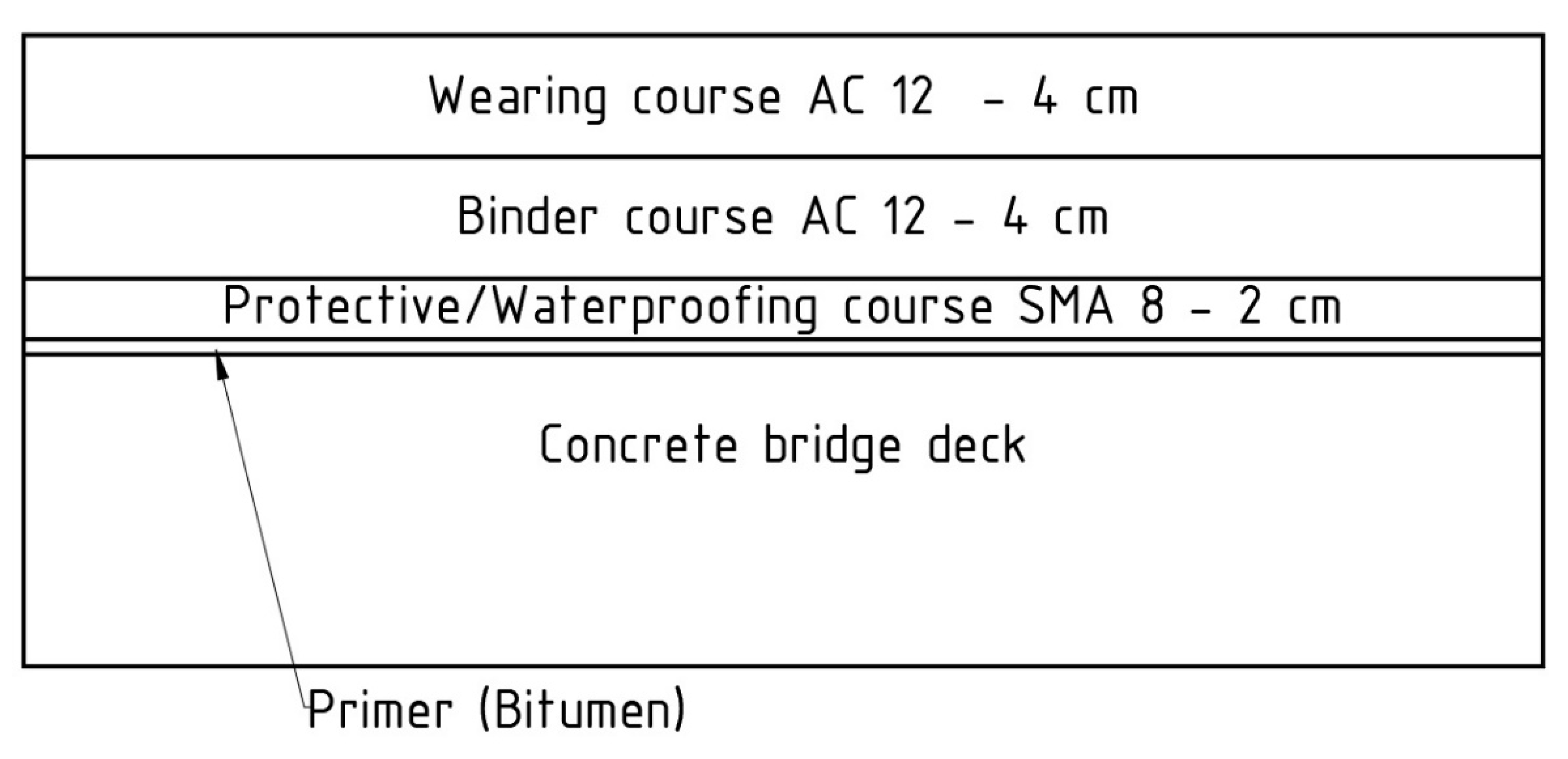
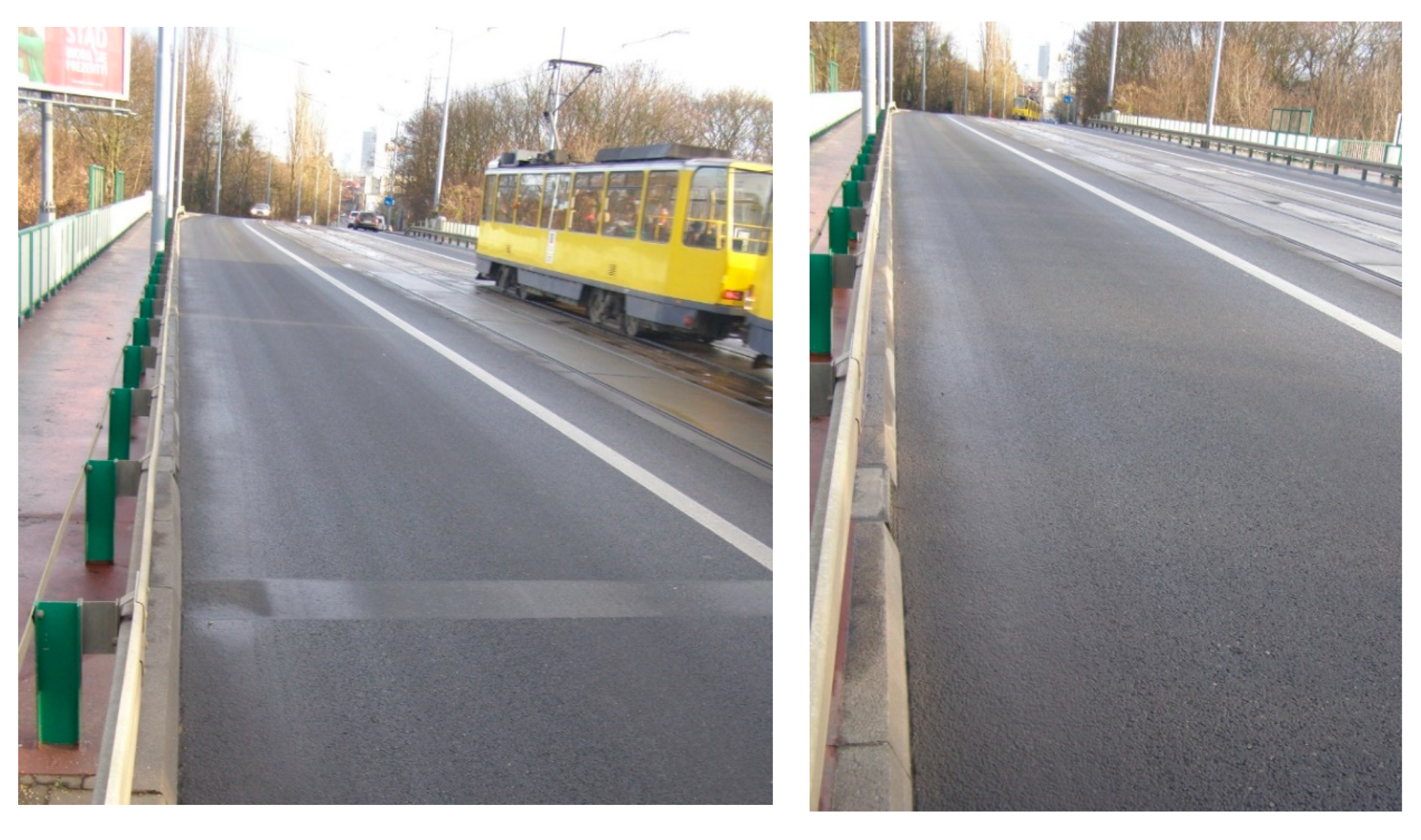
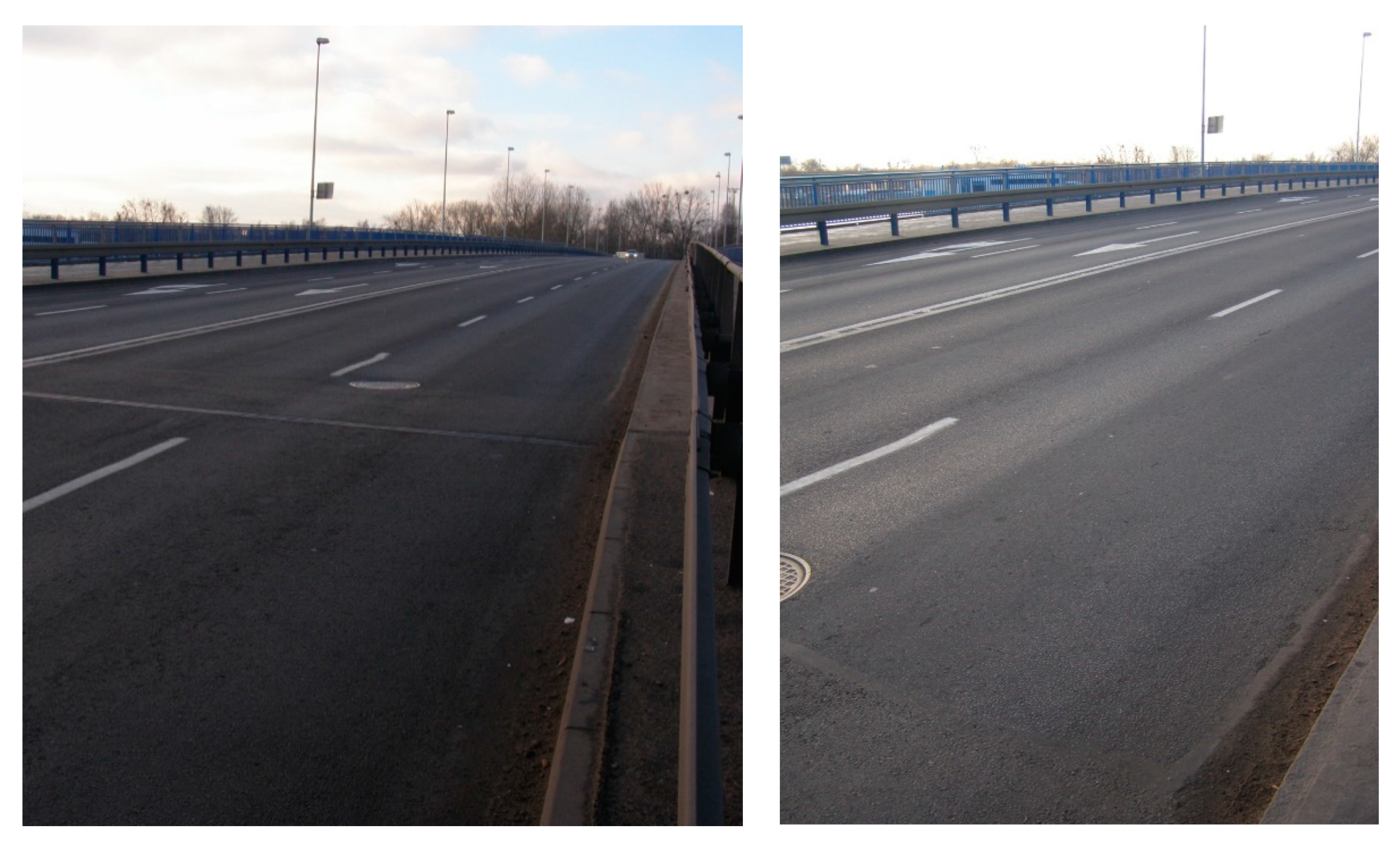
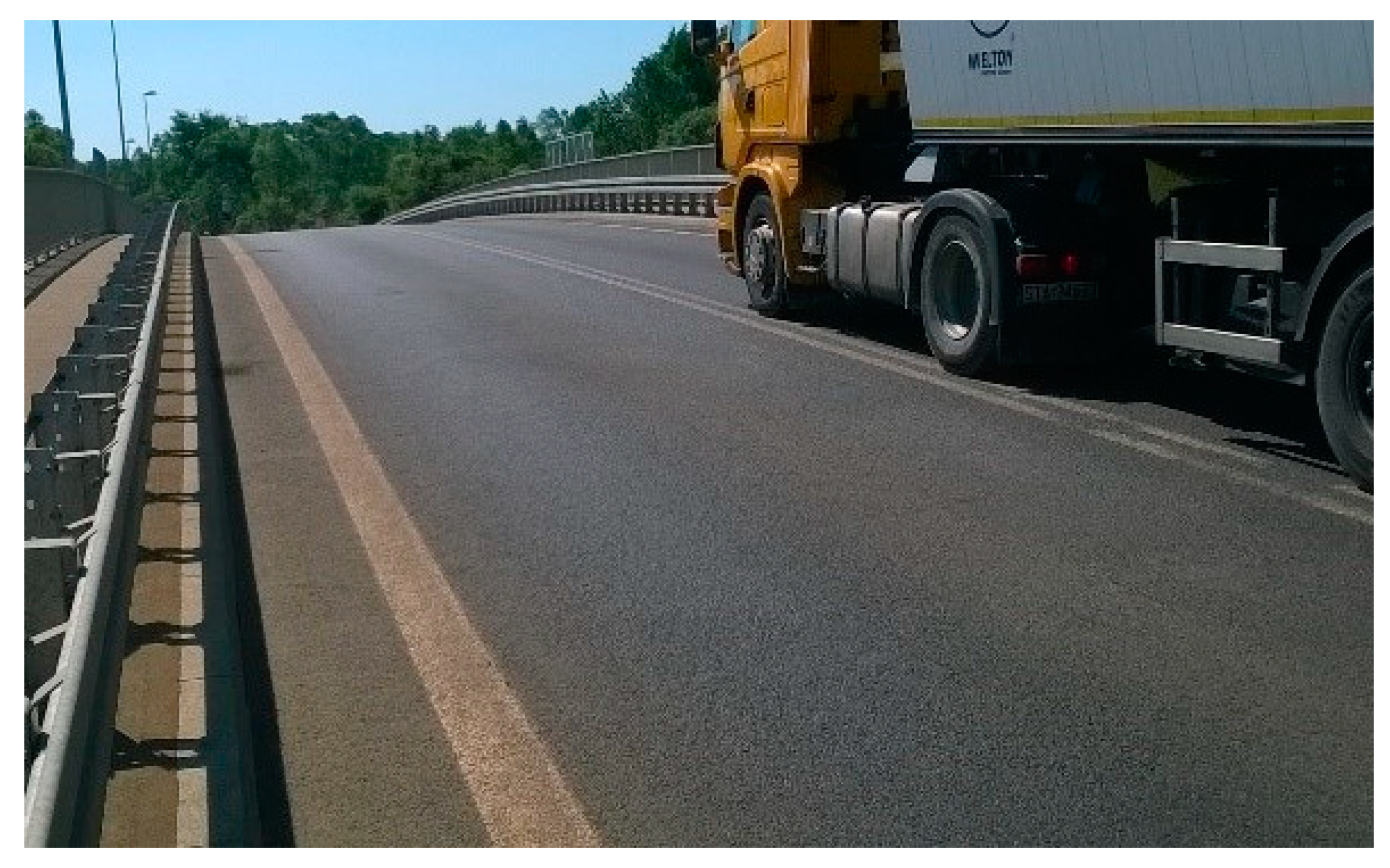
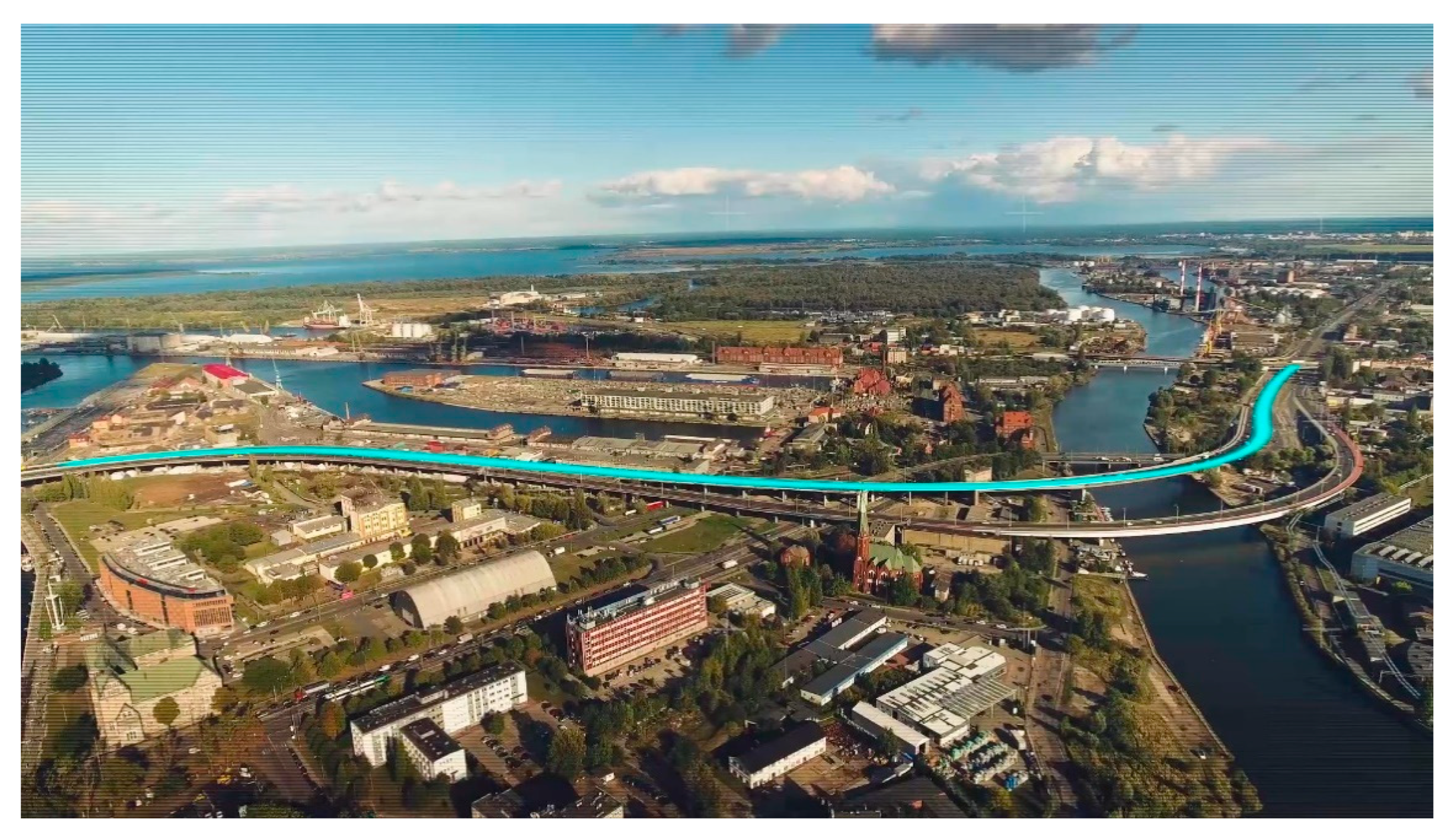


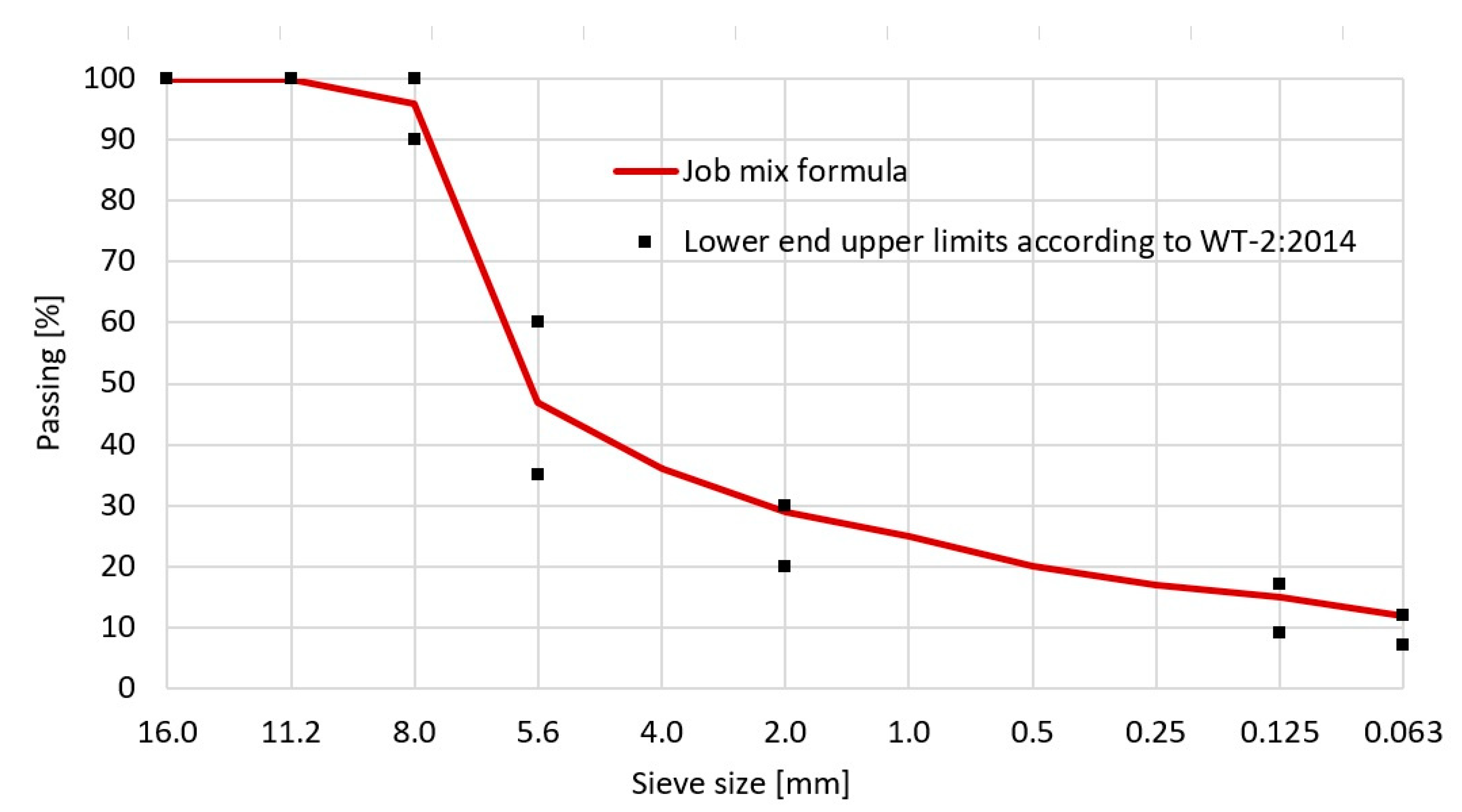
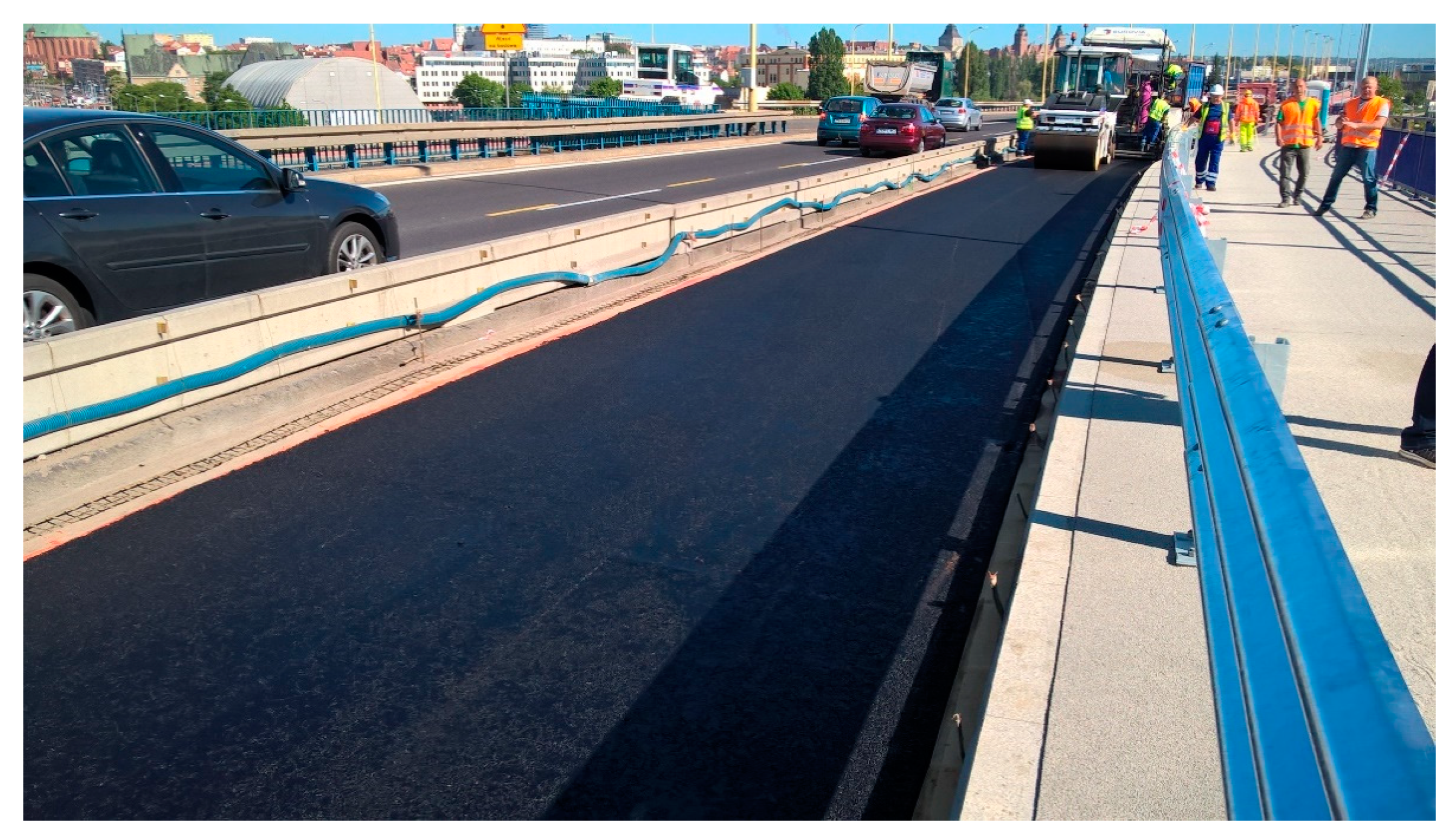
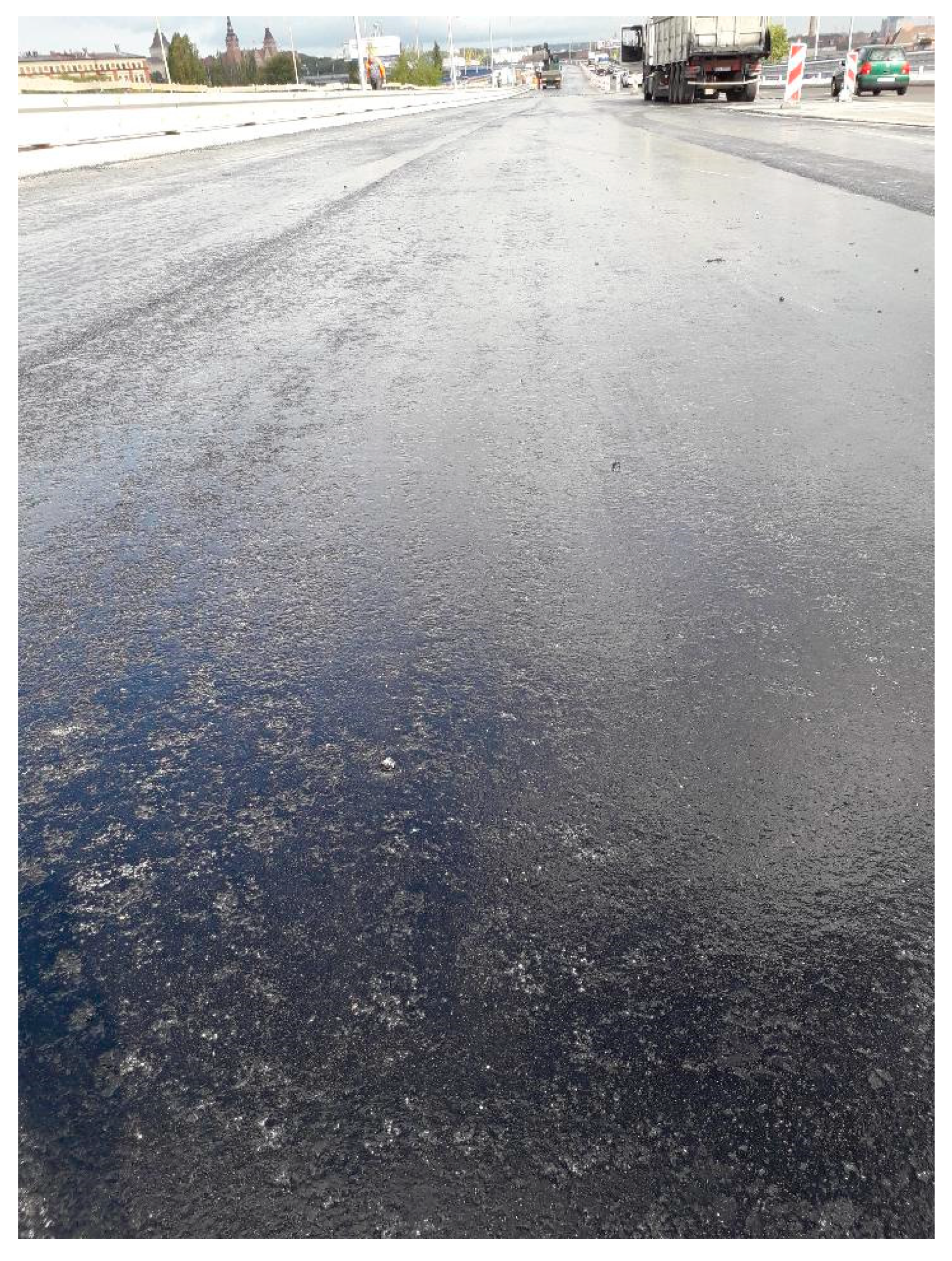
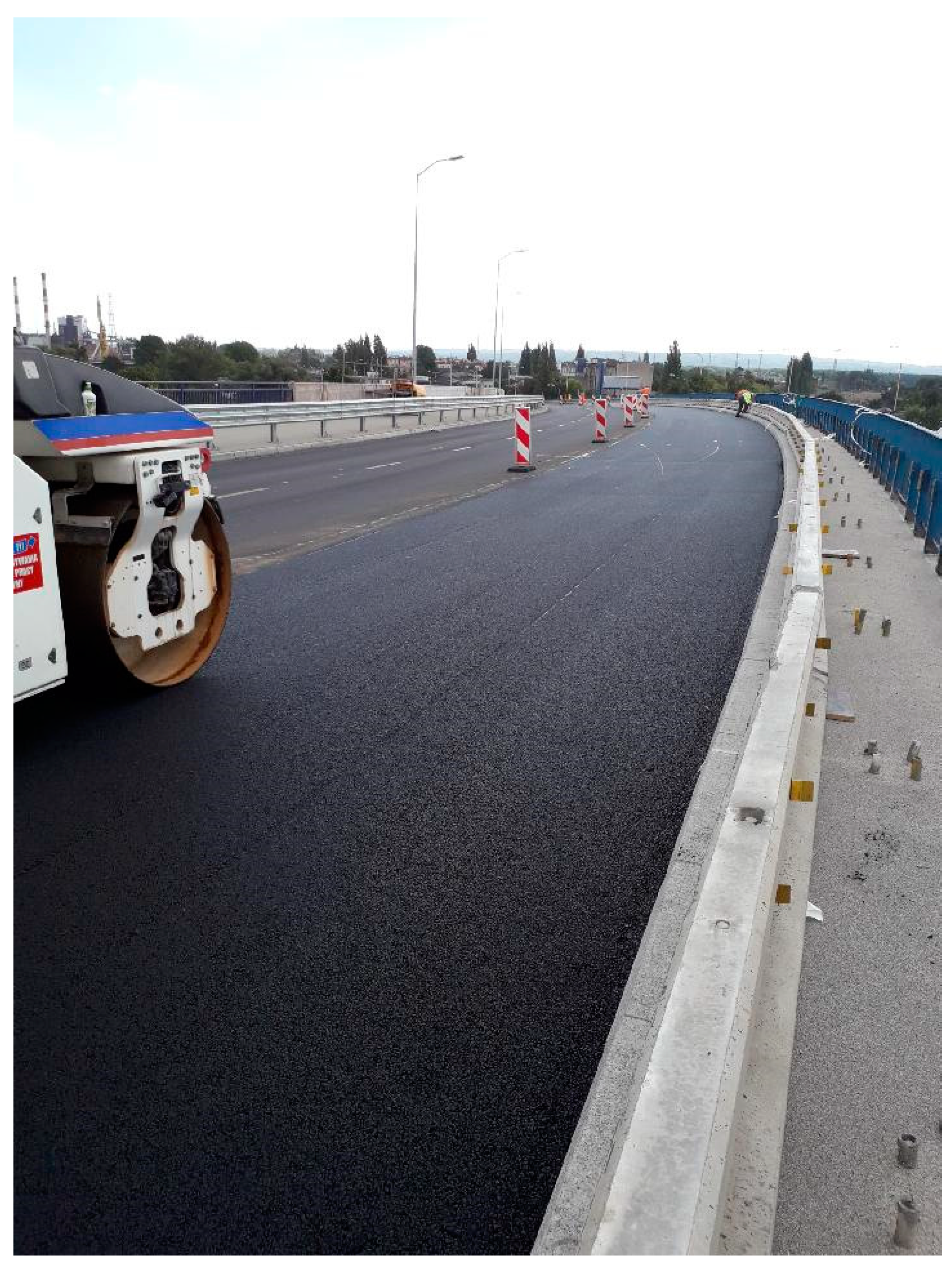
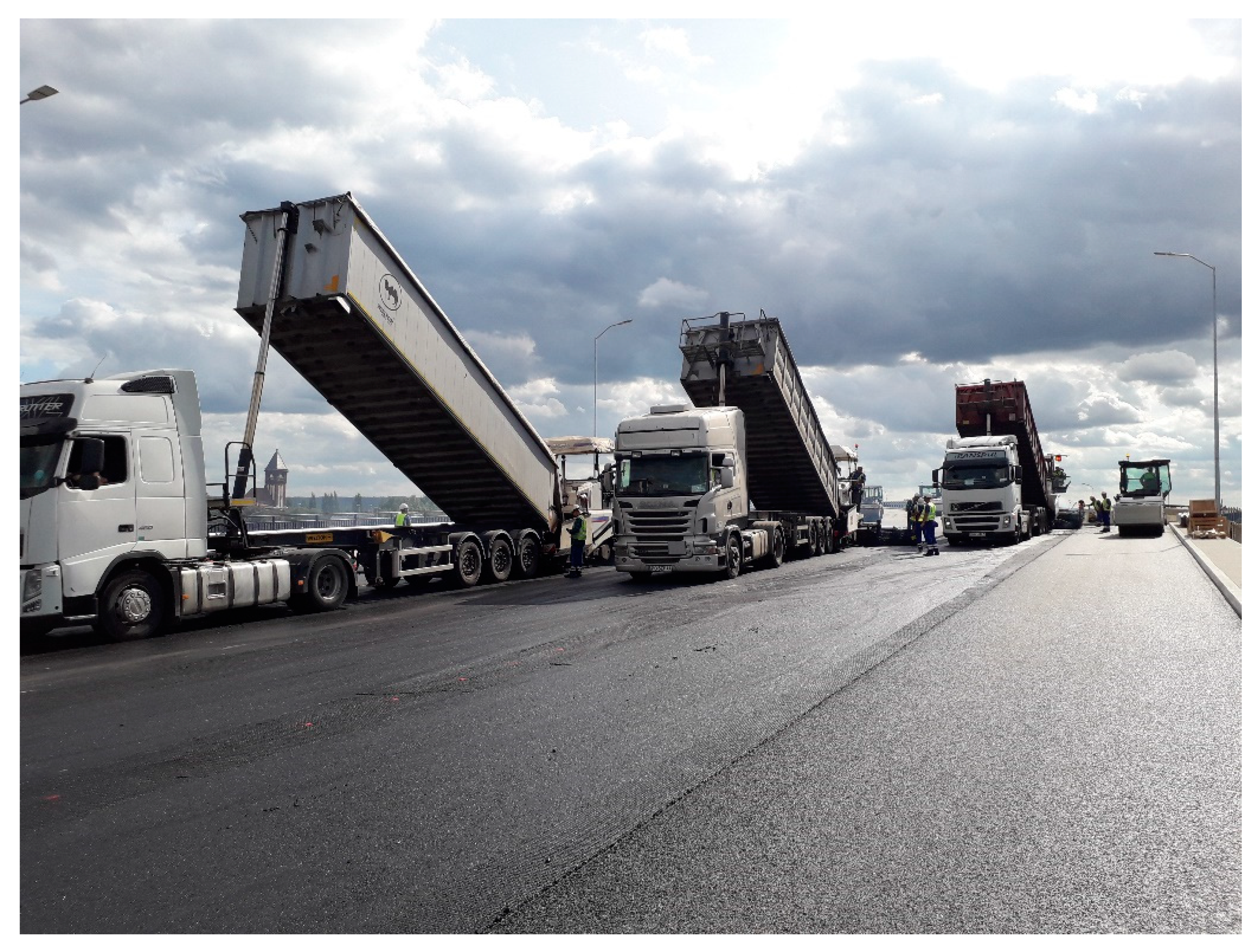

| Type of Test | Standard | Result | |||
|---|---|---|---|---|---|
| 50/70 | PMB 45/80-65 | PMB 65/105-60 | |||
| Penetration (P) (100 g, 5 s) (× 0.1 mm) | 25 °C | EN 1426:2015-08 [46] | 62.1 | 63.2 | 74.0 |
| 5 °C | 10.5 | 11.5 | 14.3 | ||
| Softening point (TR&B) (5 °C/min) [°C] | EN 1427:2015-08 [47] | 50.2 | 75.6 | 70.8 | |
| BBR bending beam test (−10, −16, −22, −28 °C) | T(S)60 [°C] | EN 14,771 [48] | −16.6 | −18.6 | −20.8 |
| T(m)60 [°C] | −15.7 | −15.1 | −21.1 | ||
| S(T)−16 [MPa] | 302 | 241 | 181 | ||
| Elastic recovery (10 °C) [%] | EN 13,398 [49] | 13 | 93 | 92 | |
| Penetration index (Ip) [−] | EN 12591:2010 (Annex A) [50] | 0.24 | 0.53 | 0.77 | |
| Property | SMA-MA 8 50/70 | SMA-MA 8 45/80-65 | SMA-MA 8 65/105-60 |
|---|---|---|---|
| Failure Temperature Tfailure (°C) | −28.5 | −34.8 | −36.3 |
| Failure Stress σcry,failure (MPa) | 3.2 | 5.0 | 5.2 |
| Property | Compaction according to EN 13108-20 | Test Method | Requirements according to TS (1) | Value |
|---|---|---|---|---|
| Air Void Content, V (%) | C.1.1, impact compaction, 2 × 25 blows, EN 12697-30 [53] | EN 12697-8 [54] | Vmax1.5 | 1.3 |
| Air Void Content, V (%) | C.1.2, impact compaction, 2 × 50 blows, EN 12697-30 [53] | EN 12697-8 [54] | Vmax1.0 | 0.7 |
| Resistance to permanent deformation of the protective layer (SMA-MA) WTSAIR (mm/103 cycles) PRDAIR (%) | C.1.20, slab compactor, P98-P100, EN 12697-33 [55] | EN 12697-22 [56], EN 13108-20 [57], D.1.4 (2) | WTSAIRmax0,50 PRDAIRmax16.0 | 0.10 13.2 |
| Resistance to permanent deformation of the layer package (protective and wearing courses) WTSAIR (mm/103 cycles) PRDAIR (%) | C.1.20, slab compactor, P98-P100, EN 12697-33 [55] | EN 12697-22 [56], EN 13108-20 [57], D.1.5 (3) | WTSAIRmax0,15 PRDAIRmax9.0 | 0.09 8.1 |
| Water sensitivity (%) | C.1.1, impact compaction, 2 × 35 blows, EN 12697-30 [53] | EN 12697-12 (4) [58] | ITSRmin90 | 98 |
| Binder drainage (%) | – | EN 12697-18 [59] | BDmax0.6 | 0.5 |
© 2020 by the authors. Licensee MDPI, Basel, Switzerland. This article is an open access article distributed under the terms and conditions of the Creative Commons Attribution (CC BY) license (http://creativecommons.org/licenses/by/4.0/).
Share and Cite
Budziński, B.; Mieczkowski, P. Application of Innovative SMA-MA Mixtures on Bridges. Appl. Sci. 2020, 10, 6958. https://doi.org/10.3390/app10196958
Budziński B, Mieczkowski P. Application of Innovative SMA-MA Mixtures on Bridges. Applied Sciences. 2020; 10(19):6958. https://doi.org/10.3390/app10196958
Chicago/Turabian StyleBudziński, Bartosz, and Paweł Mieczkowski. 2020. "Application of Innovative SMA-MA Mixtures on Bridges" Applied Sciences 10, no. 19: 6958. https://doi.org/10.3390/app10196958
APA StyleBudziński, B., & Mieczkowski, P. (2020). Application of Innovative SMA-MA Mixtures on Bridges. Applied Sciences, 10(19), 6958. https://doi.org/10.3390/app10196958





